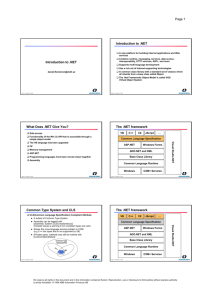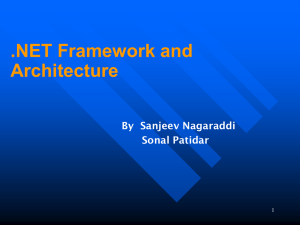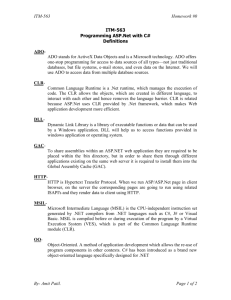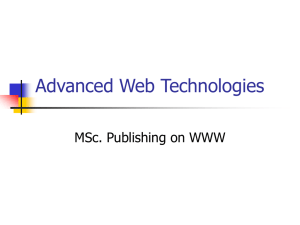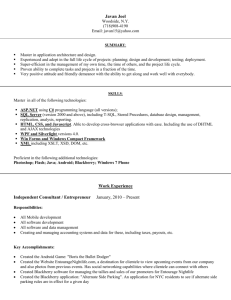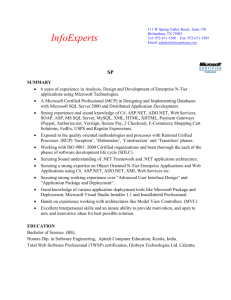To .Net or not to .Net
advertisement
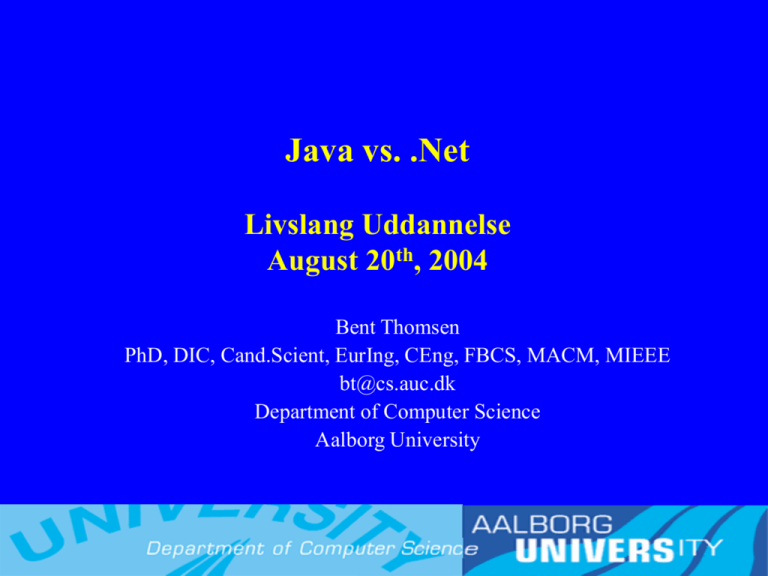
Java vs. .Net
Livslang Uddannelse
August 20th, 2004
Bent Thomsen
PhD, DIC, Cand.Scient, EurIng, CEng, FBCS, MACM, MIEEE
bt@cs.auc.dk
Department of Computer Science
Aalborg University
1
What is Microsoft .Net?
• It is a vision
– The platform for the digital future
– ‘.NET is Microsoft’s platform for a new computing model
built around XML Web Services’
Microsoft Corporation Annual Report, 2001
• It is a brand name
– Applied to many things
• It is a set of products and technologies
–
–
–
–
Infrastructure
Tools
Servers
Services
• .Net is Microsoft’s core business Strategy
2
A Unified Programming Model
Consistent API availability regardless of
language and programming model
.NET Framework
RAD,
Composition and
Delegation
VB Object
Model
Subclassing,
Power and
Expressiveness
MFC/ATL
Stateless,
code embedded
in HTML pages
ASP
Windows API
3
.NET Technologies
• The .NET Framework
– The CLR with support for XML Web services and more
– Supporting Visual Basic.NET, C#, C++, and more
• The .Net development tools
– Visual Studio.Net
• The .NET Enterprise Servers
– BizTalk Server 2003, SQL Server 2003, Commerce Server
2003 and more
• The .Net Services
– Passport, My Services, bCentral, expedia and more
4
Microsoft .NET
Web services support across the Microsoft platform
Services
Servers
Experiences
& Solutions
Tools
Clients
5
The Core of .NET Framework: FCL & CLR
• Common Language Runtime
–
–
–
–
Garbage collection
Language integration
Multiple versioning support (no more DLL hell!)
Integrated security
• Framework Class Library
– Provides the core functionality:
ASP.NET, Web Services, ADO.NET, Windows
Forms, IO, XML, etc.
6
.NET Framework
Common Language Runtime
–
–
–
–
CLR manages code execution at runtime
Memory management
• Kills entire classes of bugs (e.g., memory corruption, ref counting)
Thread management, etc.
Auto-versioning, no more DLL Hell
Common Language Runtime
Operating System
7
.NET Framework
Base Class Library
– Object-oriented collection of reusable types
– Collections, I/O, Strings, …
.NET Framework (Base Class Library)
Common Language Runtime
Operating System
8
.NET Framework
Data Access Layer
– Access relational databases
– Disconnected data model
– Work with XML
ADO .NET and XML
.NET Framework (Base Class Library)
Common Language Runtime
Operating System
9
.NET Framework
ASP.NET & Windows Forms
– Create application’s front-end – Web-based user
interface, Windows GUI, Web services, …
ASP .NET
Web Forms Web Services
Mobile Internet Toolkit
Windows
Forms
ADO .NET and XML
.NET Framework (Base Class Library)
Common Language Runtime
Operating System
10
.NET Framework
System.Web
Services
Description
Discovery
Protocols
System.Windows.Forms
UI
Design
Component
Model
HTML Controls
Web Controls
System.Drawing
Cache
Security
Drawing 2D
Printing
Configuration
Session State
Imaging
Text
System.XML
System.Data
ADO.NET
Design
SQL Client
SQL ServerCE
XML Document
Xslt/XPath
Serialization
Reader/Writers
System
Collections
Security
IO
Net
Configuration
Service Process
Text
Reflection
Diagnostics
Globalization
Resources
Threading
Runtime
Interop Services
Remoting
Serialization
11
.NET Framework
Programming Languages
– Use your favorite language
C++
C#
VB.NET Perl
…
J#
ASP .NET
Web Forms Web Services
Mobile Internet Toolkit
Windows
Forms
ADO .NET and XML
.NET Framework (Base Class Library)
Common Language Runtime
Operating System
12
.NET Framework
Common Language Specification
C++
VB
Common
Language
C#
Perl Specification
J#
…
ASP .NET
Web Forms Web Services
Mobile Internet Toolkit
Windows
Forms
ADO .NET and XML
.NET Framework (Base Class Library)
Common Language Runtime
Operating System
13
Common Type System (CTS)
•
•
•
All .NET languages have the same primitive data types. An
int in C# is the same as an int in VB.NET, COBOL.Net,
Haskell, …
When communicating between modules written in any .NET
language, the types are guaranteed to be compatible on the
binary level
Types can be:
– Value types – passed by value, stored in the stack
– Reference types – passed by reference, stored in the heap
•
Strings are a primitive data type now
14
Common Language Specification (CLS)
•
Any language that conforms to the CLS is a .NET
language
•
A language that conforms to the CLS has the ability
to take full advantage of the Framework Class
Library (FCL)
•
CLS is standardized by ECMA
15
.NET Languages
•
Languages provided by Microsoft
–
•
Third-parties languages
–
•
Cross-language inheritance and exceptions handling
Object system is built in, not bolted on
–
•
Perl, Python, Pascal, APL, COBOL, Eiffel, Haskell, ML,
Oberon, Scheme, Smalltalk…
Advanced multi-language features
–
•
C++, C#, J#, VB.NET, JScript
No additional rules or API to learn
All compile to .Net Assemblies
–
Contains MSIL and metadata
16
Intermediate Language
• .NET languages are compiled to an Intermediate
Language (IL)
• IL is also known as MSIL or CIL
• CLR compiles IL in just-in-time (JIT) manner –
each function is compiled just before execution
• The JIT code stays in memory for subsequent
calls
• Recompilations of assemblies are also possible
17
Example of MSIL Code
.method private hidebysig static void Main() cil
managed
{
.entrypoint
// Code size
11 (0xb)
.maxstack 8
IL_0000: ldstr
"Hello, world!"
IL_0005: call
void
[mscorlib]System.Console::WriteLine(string)
IL_000a: ret
} // end of method HelloWorld::Main
18
.Net Assemblies
Compilation
Assembly
Source Code
Compiler
csc.exe or vbc.exe
C++, C#, VB or
any .NET
language
DLL or EXE
19
.Net Execution Model
Common Language Runtime
Source
code
Managed
code
VB
C#
C++
Compiler
Compiler
Compiler
Assembly
IL Code
Assembly
IL Code
Assembly
IL Code
Common Language Runtime
JIT Compiler
Native Code
Operating System Services
20
Managed Code Execution
DEVELOPMENT
Source code
public static void Main(String[] args )
{ String usr; FileStream f; StreamWriter w;
try {
usr=Environment.GetEnvironmentVariable("USERNAME");
f=new FileStream(“C:\\test.txt",FileMode.Create);
w=new StreamWriter(f);
public static void Main(String[] args )
w.WriteLine(usr);
{ String usr; FileStream f; StreamWriter w;
w.Close();
try {
} catch (Exceptionusr=Environment.GetEnvironmentVariable("USERNAME");
e){
Console.WriteLine("Exception:"+e.ToString());
f=new FileStream(“C:\\test.txt",FileMode.Create);
}
w=new StreamWriter(f);
}
w.WriteLine(usr);
w.Close();
} catch (Exception e){
Console.WriteLine("Exception:"+e.ToString());
}
}
Compiler
Evidence
Host
Policy
Manager
DEPLOYMENT
Assembly
PE header + MSIL +
Metadata + EH Table
Assembly
Loader
Policy
<?xml version="1.0" encoding="utf-8" ?>
<configuration>
<mscorlib>
<security>
<policy>
<PolicyLevel version="1">
<CodeGroup class="UnionCodeGroup"
version="1"
PermissionSetName="Nothing"
Name="All_Code"
Description="Code group
grants no permissio
ns and forms the root of the code group tree.">
<IMembershipCondition clas
s="AllMembershipCondition"
version="1"/>
<CodeGroup class="UnionCodeGroup"
version="1"
PermissionSetName="FullTrust"
Granted
permissions
GAC,
app. directory,
download cache
Permission request
(class)
(method)
Class
Loader
NGEN
EXECUTION
Assembly info
Module
+ Class list
PEVerify
Vtable +
Class info
JIT +
verification
CLR Services
GC
Exception
Native code Class init
+ GC table
Security
21
.NET Security
• Role-based Security
– What the user is allowed to do within the application
– .NET Roles = Windows Active Directory® groups
• Code Access Security
– What the code is allowed to do on this machine
– Evidence Based (Policies, Permissions, Evidence)
• Cryptography Built In to .NET FX
22
Visual Basic .NET
•
•
Evolution, not revolution, of language used by
developers worldwide
Builds on existing technology while adding power
–
–
–
–
•
True OOP
Multithreading
NT Services
Web Services
The fastest way to build scalable applications for
industry
23
Visual J# .NET
•
•
•
Native support for XML Web services
Fully integrated with Visual Studio .NET
development environment
Full access to the .NET Framework
–
–
•
ASP.NET, ADO.NET, Windows Forms
Integration with >20 other languages
Protection of existing investments
–
–
Use java language syntax on .NET
Move applications and skills forward
24
Visual C++ .NET
Continue to provide most powerful
and flexible language
• Better ANSI/ISO conformance
• Enable seamless, incremental use
of .NET Framework
• Enhanced ATL Servers
• Improved ATL and MFC Clients
• Enhanced STL
25
Visual C# .NET
Component Oriented Language
• C# is the first “component oriented” language in the
C/C++ family
• Component concepts are first class:
– Properties, methods, events
– Design-time and run-time attributes
– Integrated documentation using XML
• Enables one-stop programming
– No header files, IDL, etc.
– C++ heritage – simplification with no unnecessary
sacrifices
• If you are serious about .Net you need to learn C#
26
C#
• Hello world
using System;
class HelloWorld {
public static void Main() {
Console.WriteLine(“Hello World!");
}
}
>csc HelloWorld.cs
>Hello World!
27
C#
• Properties
public class button {
private string
caption;
public string
Caption {
get {
return caption;
}
set {
if (value !=
null)
caption =
value;
}
}
}
button b = new button();
b.Caption = “abc”
string s = b.Caption;
28
C#
• Parameter Passing
By Value
By Reference
public static void Swap(ref int x, ref int y)
{
int z = x;
x = y;
y = z;
}
29
C#
• Pointers
– Not recommended for use
public struct Node {
public int value;
public unsafe Node* next;
}
public unsafe class A {
. . .
public class A {
public unsafe void B (char *p) {
. . .
30
C#
• Boxing / Unboxing
– Allows value types to be converted to and from objects automatically
ArrayList list = new ArrayList();
int z = 100;
list.Add(1);
list.Add(13.12);
list.Add(z); //integers are automatically
boxed
//when they are added to the
list
31
C#
• Versioning
– C# requires developers to clearly state their intent
• Use of the keyword ‘new’ and ‘override’
Class Derived B {
new public void x () {
. . .
Class Derived B {
public override void x () {
. . .
32
C# 2.0 Language Enhancements
•
•
•
•
Generics
Anonymous methods
Iterators
Partial types
33
Generics
public class List<T> {
private T[] elements;
private int count;
public void Add(T element) {
if (count == elements.Length) Resize(count * 2);
elements[count++] = element;
}
public T this[int index] {
get { return elements[index]; }
List<int>
intList
set { elements[index]
= value;
} = new List<int>();
}
intList.Add(1);
// No boxing
intList.Add(2);
// No boxing
public int Count {
// Compile-time error
get { return count; intList.Add("Three");
}
}
int i = intList[0]; // No cast required
}
34
Visual Studio .NET
• Development tool that contains a rich set of productivity and
debugging features
–
–
–
–
–
–
–
Supports managed and unmanaged applications
Supports C#, C++, VB.NET, …
Many useful tools and wizards
Windows Forms Designer
ASP.NET Web Forms Designer
Web Services support
SQL Server integration with ADO.NET and XML
• VS.NET is not part of the .NET Framework
– Not necessary to build or run managed code
– The .NET Framework SDK includes command line compilers
35
VS.NET – Single Development Environment
• From Visual Studio.NET you can:
–
–
–
–
–
–
Write code
Design user interface
Study documentation
Debug
Test
Deploy
• Same tools for all languages
• Same tools for all platforms
36
Visual Studio .NET
37
Referencing the Framework
38
.NET Applications
•
•
•
•
Web Form – Next Generation ASP Page
Win Form – Next Generation Win32 App
Web Services – Key to Interoperability
Others –
–
–
–
–
–
Server Objects
Console Applications
Window Services
Mobile Clients
Many more…
39
ASP.NET
•
Server-side Web Forms and Web Services components
separate code from content
–
–
–
–
•
•
•
•
•
Developer productivity increases
Tools easily use ASP.NET
Any programming language: full VB, JScript, C++, COBOL, Perl,
etc.
40% to 70% reduction in lines of code
Compiled
No-touch deployment system
Intelligent state management
Backwards compatible with ASP
Controls sense client and adapt output: HTML, DHTML,
WML
40
What Is an
XML Web Service?
• A Component That Uses XML & HTTP To Define and
Deliver A Service
–
–
–
–
Global reach
Based on open set of standards
Reuse across platforms
Works with any operating system, programming language, or
network
– Expose legacy code
• Different systems can actually talk
41
Web Services
Open Standards & Protocols
• XML
– Universal data format
– Standards-based integration
– User-customizable
• HTTP
– Ubiquitous protocol
– Universally understood
42
VS.NET and Web Services
•
Expose functionality as service
–
–
–
•
Reuse existing Web Services
–
–
•
No need to learn XML, SOAP, or WSDL
Interface is automatically generated
Seamless deployment
VS.NET generates the plumbing
Full IntelliSense support
Build and consume with any VS language
43
Software as a Service
Visual Studio .Net and the Net Framework
•
Built-in Support for Developing and Consuming Web
Services
–
–
–
–
Based entirely on open standards
Automatically generates WSDL
Automatically provides test page
Attribute based – No heavy coding needed
[WebMethod]
Public Function HelloWorld() as String
return “Hello World”
End Function
WSDL
Compiler
Test
Page
Web
Service
Object
44
Windows Forms
•
Rich, powerful client UI
–
–
–
•
Secure
–
–
•
Control anchoring, visual inheritance
Shared across all .NET languages
No-touch deployment
Semi-trusted browser component
Fully-trusted local application
Full Web Service integration
45
.Net on other Platforms
• .Net Compact Framework
– PocketPC, XScale, ARM, …
• SSCLI
– BSD Unix, Mac OS X
• Mono
– Linux
46
.Net CF
• Target mobile and embedded devices
• Portable subset of .NET Framework
– No new ‘compact’ namespaces
– Visual Basic .NET and C# compiler
support in v1
• Leverage Visual Studio .NET
– Run managed .EXEs and .DLLs directly
– Debug with Visual Studio .NET
• Peacefully co-exist with host OS
– Run on native threads, P/Invoke to call native code
47
Execution Engine Commonalities
• Verifiable type safe execution
– No uninitialized variables, unsafe casts, bad array indexing,
bad pointer math
• Garbage Collection
– No ref-counting, no leaks
• JIT compilation
• Error handling with exceptions
• Common type system
– Call, inherit, and source-level debug across different
languages
Execution Engine Differences
•
•
•
•
No ASP.NET
COM Interop
–
Good support for calling native DLLs
–
–
–
Support for calling COM objects using dll wrappers
No support for writing COM/ActiveX objects
No Install-time JIT (nGen)
No Reflection Emit
No Remoting
–
•
• • P/Invoke – PlatformInvoke enables calls to Win32
DLLs
Client web services is fully supported
No Generic Serialization
–
–
Datasets can be serialized to XML
No binary Serialization
Other Differences
• Class libraries are a subset
(about 25%)
• Different size and scalability characteristics
• Compact Additions
– IrDA support
– SQL Server CE managed classes
– Device-specific controls
50
.NET Framework
System.Web
Services
Description
Discovery
Protocols
System.Windows.Forms
UI
Design
Component
Model
HTML Controls
Web Controls
System.Drawing
Cache
Security
Drawing 2D
Printing
Configuration
Session State
Imaging
Text
System.XML
System.Data
ADO.NET
Design
SQL Client
SQL ServerCE
XML Document
Xslt/XPath
Serialization
Reader/Writers
System
Collections
Security
IO
Net
Configuration
Service Process
Text
Reflection
Diagnostics
Globalization
Resources
Threading
Runtime
Interop Services
Remoting
Serialization
51
.NET Compact Framework
System.Web
Services
Description
Discovery
Protocols
System.Windows.Forms
UI
Design
Component
Model
HTML Controls
Web Controls
System.Drawing
Cache
Security
Drawing 2D
Printing
Configuration
Session State
Imaging
Text
System.XML
System.Data
ADO.NET
SQL Client
XML Document
Serialization
Design
SQL ServerCE
Xslt/XPath
Reader/Writers
System
Collections
IO
Configuration
Security
Net
Service Process
Text
Reflection
Diagnostics
Globalization
Resources
Threading
Runtime
Interop Services
Remoting
Serialization
52
How to Create a Smart Device Application
• Create a New Smart
Device Application
Project
• Choose the platform
and type of project
• Add additional forms,
controls, and code
53
What Are Smart Device Projects?
• Smart Device Projects are used to develop applications that target
the .NET Compact Framework
• Supported devices include:
– Pocket PC 2000, 2002 and 2003
– Pocket PC 2002 Phone Edition
– SmartPhone 2003
– Custom-designed embedded devices built with the Windows
CE .NET 4.1 operating system
• Supported languages are Visual Basic and C#
54
.NET Framework on Linux
• Mono Project
– Open Source C# compiler, CLR and Framework Class Library
– Runs on various platforms and hardware:
• Linux, Unix, FreeBSD, Windows – JIT-compiler for x86
• s390, SPARC, PowerPC – interpreter for these hardware
architectures
– Supports also:
• ADO.NET and XML
• Windows Forms (not fully)
• ASP.NET
• Web Services
55
.NET Framework on Linux (2)
• Mono Project
– Runs .NET portable executables on Linux, e.g.
mono myapp.exe
– Compiles .NET applications to portable executables, e.g.
mcs myapp.cs
– The obtained .exe file can taken and run on Windows
• DotGNU Portable.NET
– Build and execute .NET applications on GNU/Linux, Windows, Solaris,
NetBSD, FreeBSD, and MacOS X
56
.NET (R)Evolutionary
• Evolutionary
– Existing Skills Migrate Smoothly
– Interoperates with Existing Applications
– Extension of WinDNA Architecture
• Revolutionary
–
–
–
–
Common Language Runtime
Deployment / Versioning (Ends DLL Hell)
Web Services & XML Integration
Evidence Base Code Access Security
57
Future of .Net
– .Net is Microsoft’s core strategy
• .Net will be part of OS in the next generation of Windows
• Lot’s of innovation in Longhorn – Avalon, indigo, WinFS
58
